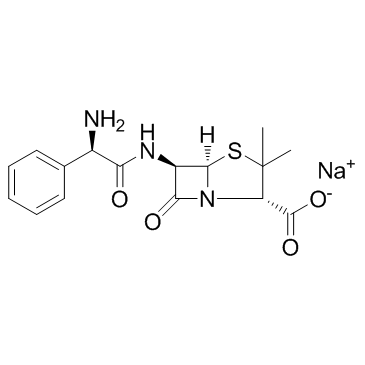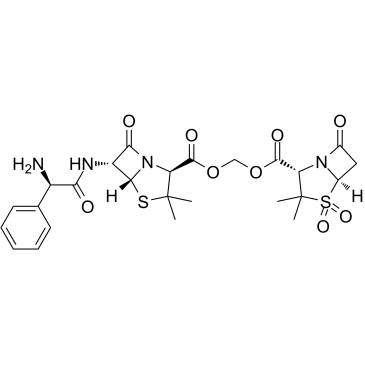69-52-3
| 中文名 | 氨苄青霉素钠 |
|---|---|
| 英文名 | ampicillin sodium |
| 中文别名 | 氨苄西林钠 |
| 英文别名 |
omnipen-n
Amcill-s pena/n Anhypen XLD AGAR penialmen Alppen-N EINECS 200-708-1 Alpen-n Cilleral sodium ampicillin salt MFCD00064313 Ampicillin sodium sodium ampicillin Citteral AmpicillinSodium Ampicillin (sodium) |
| 描述 | Ampicillin sodium是一种广谱β-内酰胺类抗生素,可对抗多种革兰氏阳性和革兰氏阴性细菌 (bacteria)。 |
|---|---|
| 相关类别 | |
| 靶点 |
Bacterial[1] |
| 体外研究 | 氨苄青霉素以剂量依赖性方式抑制猪源大肠杆菌的生长。氨苄青霉素的有效抑制浓度为2.5 uG/mL [1]。 |
| 体内研究 | 氨苄西林在减轻11周龄猪出血性肠炎的症状方面非常有效[1]。氨苄西林在胆汁中产生的最大浓度是血清中的两倍。口服给药后氨苄西林的峰值浓度是门静脉血液中的两倍,高于外周血[2]。氨苄西林提供针对缺血再灌注脑损伤的神经保护作用。氨苄青霉素降低MMP的活性并增加GLT-1的表达水平。氨苄青霉素预处理可显着降低全脑前脑缺血后内侧海马细胞死亡[3]。 |
| 动物实验 | 小鼠:将氨苄青霉素溶于生理盐水中。用氟烷麻醉雄性C57BL / 6小鼠,并进行双侧颈总动脉闭塞40分钟。在短暂的前脑缺血之前,每天施用氨苄青霉素(200mg / kg,腹膜内[ip])或青霉素G(6,000U / kg或20,000U / kg,ip),持续5天。在对照动物中,以相同的体积和时间表给予盐水[3]。 |
| 参考文献 |
| 沸点 | 683.9ºC at 760 mmHg |
|---|---|
| 熔点 | 215 °C (dec.)(lit.) |
| 分子式 | C16H18N3NaO4S |
| 分子量 | 371.387 |
| 精确质量 | 371.091583 |
| PSA | 140.86000 |
| LogP | 0.01250 |
| 外观性状 | 白色至灰白色固体 |
| 储存条件 | 本品应密封于4℃干燥保存。有效期2年半。 |
| 水溶解性 | H2O: 50 mg/mL, clear, very faintly yellow |
| 计算化学 | 1、 氢键供体数量:2 2、 氢键受体数量:5 3、 可旋转化学键数量:4 4、 互变异构体数量:2 5、 拓扑分子极性表面积(TPSA):116 6、 重原子数量:25 7、 表面电荷:0 8、 复杂度:568 9、 同位素原子数量:0 10、 确定原子立构中心数量:4 11、 不确定原子立构中心数量:0 12、 确定化学键立构中心数量:0 13、 不确定化学键立构中心数量:0 14、 共价键单元数量:2 |
| 更多 | 1. 性状:白色或类白色的粉末或结晶。无臭或微臭,味微苦。 2. 密度(g/mL,25/4℃): 未确定 3. 相对蒸汽密度(g/mL,空气=1):未确定 4. 熔点(ºC):205(分解) 5. 沸点(ºC,常压):未确定 6. 沸点(ºC,5.2kPa):未确定 7. 折射率:未确定 8. 闪点(ºC):未确定 9. 比旋光度(º,C=0.2,水中):+209° 10. 自燃点或引燃温度(ºC):未确定 11. 蒸气压(kPa,25ºC):未确定 12. 饱和蒸气压(kPa,60ºC):未确定 13. 燃烧热(KJ/mol):未确定 14. 临界温度(ºC):未确定 15. 临界压力(KPa):未确定 16. 油水(辛醇/水)分配系数的对数值:未确定 17. 爆炸上限(%,V/V):未确定 18. 爆炸下限(%,V/V):未确定 19. 溶解性:有吸湿性。易溶于水,稍溶于丙酮和乙醇,微溶于氯仿,不溶于乙醚。 |
Synonym:Alpen-N; Amcill-S; D-Alpha-aminobenxylpenicillin sodium salt; Ampicillin sodium sal Section 2 - COMPOSITION, INFORMATION ON INGREDIENTS
Risk Phrases: 36/37/38 42/43 Section 3 - HAZARDS IDENTIFICATION EMERGENCY OVERVIEW
Irritating to eyes, respiratory system and skin. May cause sensitization by inhalation and skin contact. Potential Health Effects Eye: Causes eye irritation. Skin: Causes skin irritation. May cause skin sensitization, an allergic reaction, which becomes evident upon re-exposure to this material. May be harmful if absorbed through the skin. Ingestion: May cause gastrointestinal irritation with nausea, vomiting and diarrhea. May be harmful if swallowed. Inhalation: Causes respiratory tract irritation. May cause allergic respiratory reaction. May be harmful if inhaled. Chronic: No information found. Section 4 - FIRST AID MEASURES Eyes: Immediately flush eyes with plenty of water for at least 15 minutes, occasionally lifting the upper and lower eyelids. Get medical aid. Skin: Immediately flush skin with plenty of water for at least 15 minutes while removing contaminated clothing and shoes. Get medical aid if irritation develops or persists. Wash clothing before reuse. Ingestion: Do not induce vomiting. If victim is conscious and alert, give 2-4 cupfuls of milk or water. Get medical aid. Inhalation: Remove from exposure and move to fresh air immediately. If not breathing, give artificial respiration. If breathing is difficult, give oxygen. Get medical aid. Notes to Physician: Section 5 - FIRE FIGHTING MEASURES General Information: As in any fire, wear a self-contained breathing apparatus in pressure-demand, MSHA/NIOSH (approved or equivalent), and full protective gear. During a fire, irritating and highly toxic gases may be generated by thermal decomposition or combustion. Extinguishing Media: Use water spray, dry chemical, carbon dioxide, or appropriate foam. Section 6 - ACCIDENTAL RELEASE MEASURES General Information: Use proper personal protective equipment as indicated in Section 8. Spills/Leaks: Vacuum or sweep up material and place into a suitable disposal container. Clean up spills immediately, observing precautions in the Protective Equipment section. Avoid generating dusty conditions. Provide ventilation. Section 7 - HANDLING and STORAGE Handling: Wash thoroughly after handling. Remove contaminated clothing and wash before reuse. Use with adequate ventilation. Minimize dust generation and accumulation. Avoid contact with skin and eyes. Keep container tightly closed. Avoid ingestion and inhalation. Storage: Store in a cool, dry, well-ventilated area away from incompatible substances. Section 8 - EXPOSURE CONTROLS, PERSONAL PROTECTION Engineering Controls: Facilities storing or utilizing this material should be equipped with an eyewash facility and a safety shower. Use adequate ventilation to keep airborne concentrations low. Exposure Limits CAS# 69-52-3: Personal Protective Equipment Eyes: Wear appropriate protective eyeglasses or chemical safety goggles as described by OSHA's eye and face protection regulations in 29 CFR 1910.133 or European Standard EN166. Skin: Wear appropriate protective gloves to prevent skin exposure. Clothing: Wear appropriate protective clothing to prevent skin exposure. Respirators: Follow the OSHA respirator regulations found in 29 CFR 1910.134 or European Standard EN 149. Use a NIOSH/MSHA or European Standard EN 149 approved respirator if exposure limits are exceeded or if irritation or other symptoms are experienced. Section 9 - PHYSICAL AND CHEMICAL PROPERTIES Physical State: Solid Color: white to off-white Odor: none reported pH: 8.0-10.0 @ 1% solu. Vapor Pressure: Not applicable. Viscosity: Not applicable. Boiling Point: Not available. Freezing/Melting Point: 419 deg F Autoignition Temperature: Not applicable. Flash Point: Not applicable. Explosion Limits, lower: Not available. Explosion Limits, upper: Not available. Decomposition Temperature: Not available. Solubility in water: Very soluble in water. Specific Gravity/Density: Not available. Molecular Formula: C16H18N3O4SNa Molecular Weight: 371.1935 Section 10 - STABILITY AND REACTIVITY Chemical Stability: Stable under normal temperatures and pressures. Conditions to Avoid: High temperatures, incompatible materials, dust generation, moisture. Incompatibilities with Other Materials: Strong oxidizers. Hazardous Decomposition Products: Carbon monoxide, oxides of nitrogen, oxides of sulfur, carbon dioxide. Hazardous Polymerization: Has not been reported. Section 11 - TOXICOLOGICAL INFORMATION RTECS#: CAS# 69-52-3: XH8400000 LD50/LC50: CAS# 69-52-3: Oral, mouse: LD50 = >5314 mg/kg; Oral, rat: LD50 = >5314 mg/kg. Carcinogenicity: Ampicillin Sodium - Not listed by ACGIH, IARC, or NTP. Other: See actual entry in RTECS for complete information. Section 12 - ECOLOGICAL INFORMATION Other No information available. Section 13 - DISPOSAL CONSIDERATIONS Dispose of in a manner consistent with federal, state, and local regulations. Section 14 - TRANSPORT INFORMATION IATA Shipping Name: Not regulated. Hazard Class: UN Number: Packing Group: IMO Shipping Name: Not regulated. Hazard Class: UN Number: Packing Group: RID/ADR Shipping Name: Not regulated. Hazard Class: UN Number: Packing group: Section 15 - REGULATORY INFORMATION European/International Regulations European Labeling in Accordance with EC Directives Hazard Symbols: XN Risk Phrases: R 36/37/38 Irritating to eyes, respiratory system and skin. R 42/43 May cause sensitization by inhalation and skin contact. Safety Phrases: S 26 In case of contact with eyes, rinse immediately with plenty of water and seek medical advice. S 36/37/39 Wear suitable protective clothing, gloves and eye/face protection. WGK (Water Danger/Protection) CAS# 69-52-3: No information available. Canada None of the chemicals in this product are listed on the DSL/NDSL list. CAS# 69-52-3 is not listed on Canada's Ingredient Disclosure List. US FEDERAL TSCA CAS# 69-52-3 is not listed on the TSCA inventory. It is for research and development use only. SECTION 16 - ADDITIONAL INFORMATION N/A |
|
毒理学数据: 急性毒性:妇女口经 LDLo : 100 mg/kg/5D ;大鼠口经 LD50 : >5314 mg/kg ; 大鼠腹腔 LD50 : 7400 mg/kg ; 大鼠皮下注射 LD50 : >5314 mg/kg ;小鼠口径LD50:>5314 mg/kg;小鼠腹腔LD50:5700 mg/kg; 小鼠皮下注射LD50:>5314 mg/kg;大鼠静脉LDLo:2657 mg/kg; CHEMICAL IDENTIFICATION
HEALTH HAZARD DATAACUTE TOXICITY DATA
|
| 符号 |

GHS08 |
|---|---|
| 信号词 | Danger |
| 危害声明 | H317-H334 |
| 警示性声明 | P261-P280-P342 + P311 |
| 个人防护装备 | dust mask type N95 (US);Eyeshields;Faceshields;Gloves |
| 危害码 (欧洲) | Xi:Irritant |
| 风险声明 (欧洲) | R42/43 |
| 安全声明 (欧洲) | S22-S36/37-S45-S36-S26 |
| 危险品运输编码 | NONH for all modes of transport |
| WGK德国 | 2 |
| RTECS号 | XH8400000 |
| 海关编码 | 2941101900 |
| 上游产品 0 | |
|---|---|
| 下游产品 1 | |
| 海关编码 | 2941101900 |
|---|



